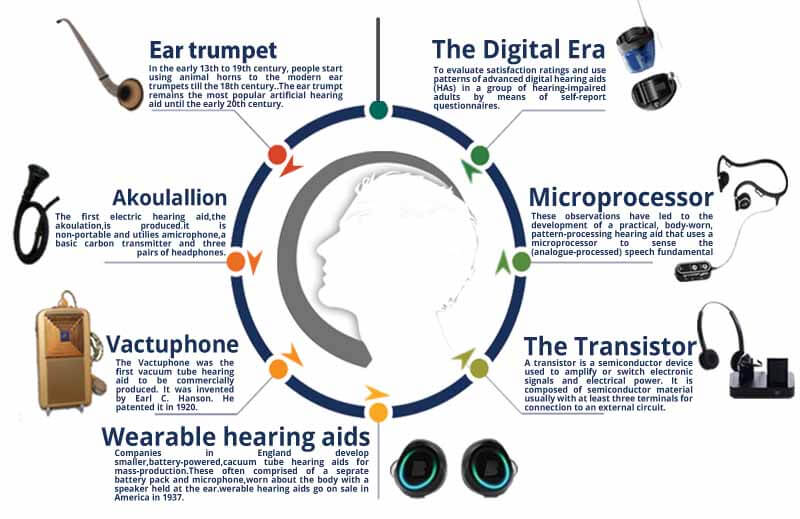
If you read the history of Hearing aids, you will get to learn that it was first invented in the 17th century. A physician suggested blowing trumpets for a patient ear as a cure for hearing loss. Humanity has bridged between weak time and digital hearing aid age. However, The action toward modern Hearing aids commence with the creation of the telephone, and the first Hearing aids were invented in 1998. The Digital Hearing aids were dispersed to the public commercially. The first Hearing aids was an external hearing aid.
You can purchase the latest hearing aids at a fair price through HearingSol, If you need more information or you have a query about Hearing Aid or Hearing Loss, just give us a call on +91-9327901950. We are always here to help you.

In the seventeenth century, the invention of 1st hearing aid was done. It would appear that phone and the primary electric listening device was made during the nineteenth century.
The hearing aid has progressed significantly from ear trumpets in the thirteenth century to Akouphone and after that to Vactophone. From Vactophone to transistor portable amplifiers to Analog then to advanced hearing machines.
1600-1900s: The Trumpet Hearing Aid Age
The Trumpet Hearing Aid developed by the mathematician Jean Leurechon. Jean Leurechon wrote the first known description of a hearing aid that is known as the ear trumpet. It’s the primary hearing aid until the turn of the 20th century and the new hearing aid is invented. These aids powerful and fairly effective ways of amplifying and directing sound, much like cupping a hand behind your ear.
17-18 Century
Ear trumpets or pipe molded gadgets began in 17 century. These ear trumpets turned into the modern and well-known treatment for the hearing misfortune in the 1700 century. However, They were wide open toward one side to gather sound and smaller at the opposite end to transmit the amplified sound into the individual’s ear. The first ear trumpet client was Ludwig Van Beethoven.
1900-1920s: The Telephone Age
In 20th century beginning the first electric hearing aids developed by Miller Reese Hutchison, by using carbon microphone. It based on the principle of telephone, But Graham Bell was not involved in this development. The carbon microphone is used because it regenerates the sound by using sound waves to compress carbon against a diaphragm. As such, these carbon models were ineffective for serious hearing loss.
1920-40s: The Vacuum Tube Age
By the 1940s, the more portable vacuum tube was introduced. Supposedly invented by Earl C. Hanson, he called his hearing aid the “Vactuphone.” This hearing aid technology was able to address the more severe hearing loss. It required two batteries, so the cost of hearing aids was high at the time. Vacuum tubes smaller but remain awkward over the next decade, until the next hearing aids design developed.
1950s-80s: The Transistor Hearing Aid Age
The transistors used in hearing aids was a huge step forward, allowing the production of more portable hearing aids. Today’s Behind the ear and In the Ear (BTE/ITE) hearing aids are available in the market and include analog technology. Analog hearing aid technology provides more comfort and sound quality as compared to other previous hearing aids, their ability to filter noise and speech were quite limited. Analog hearing aids are also used in the present day.
Late 20th: Analog To Digital
Hearing aid technology close to which we use today is introduced by Zenith Radio in the 1960s. ; in these versions, the microphone went inside the ear and was connected with small wire to an amplifier and battery unit was clipped to the ear. This technology remained the same until the 1980s, upon the introduction of digital signal processing chips to hearing aids.
Analog and Digital Hearing Aids
A chip, created in 1970 making powerful hearing machines. Besides, these consultation machines utilized a blend of analog and digital circuitry.
Analog Hearing Aids
Analog amplifiers assemble the sound from the nearby and analyze it and therefore sound heard at a more intense volume. It can’t recognize different sounds.
Advantages
- They are less expensive than computerized amplifiers.
- Colossal battery life.
- They are anything but difficult to set up.
Digital Hearing Aids
Digital amplifiers assemble the sounds from the nearby surrounding and analyze by means of DSP(Digital Signal Processor). It is a modest PC microchip chip which helps in handling and analyzing different sounds. Likewise, digital hearing aids are very like PCs.
Advantages
- Various channels are accessible to recognize different sounds.
- Customizable and dependable.
- Littler and lightweight when contrasted with simple portable amplifiers.
- Identify naturally the best stable.
21st century: High Technology
We have come a long way from the days of ear trumpets, and hearing aids continue to evolve as advanced technologies. Many hearing aids are “smart,” which are able to adapt to listening situations. Long-wearing hearing aids, which can stay in the wearer’s ear canals for a long time, have been available for several years. Eventually, in the future, hearing aids will continue to progress in performance and comfort while decreasing in size.
Read More –
- What can happen if an ear infection is left untreated?
- How does an audiologist conduct a hearing test?

